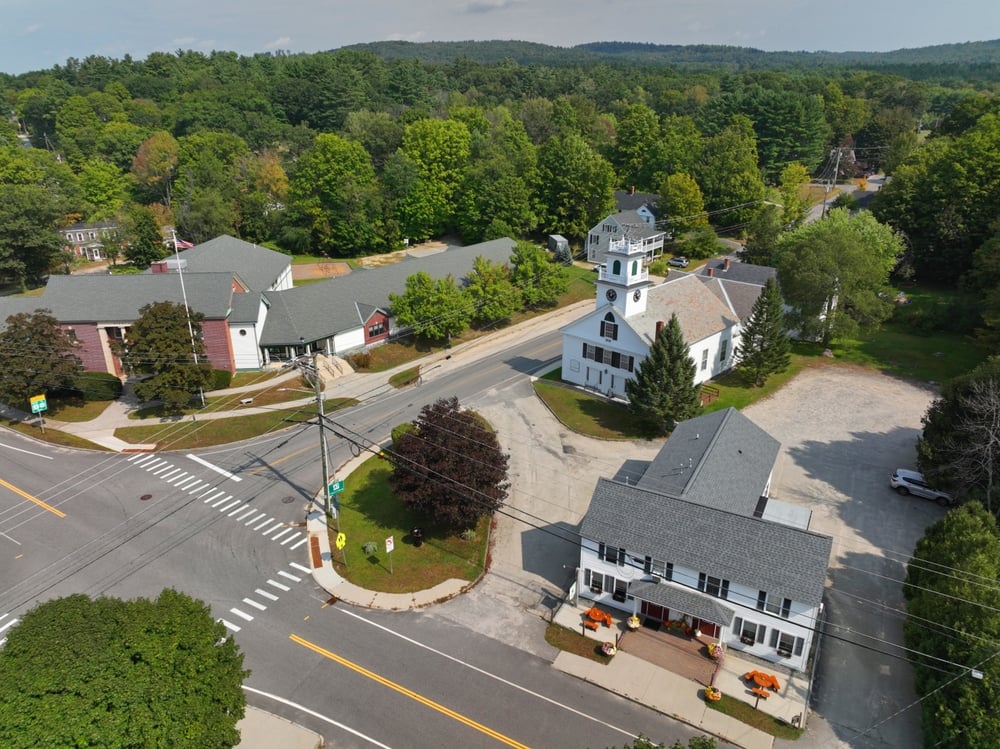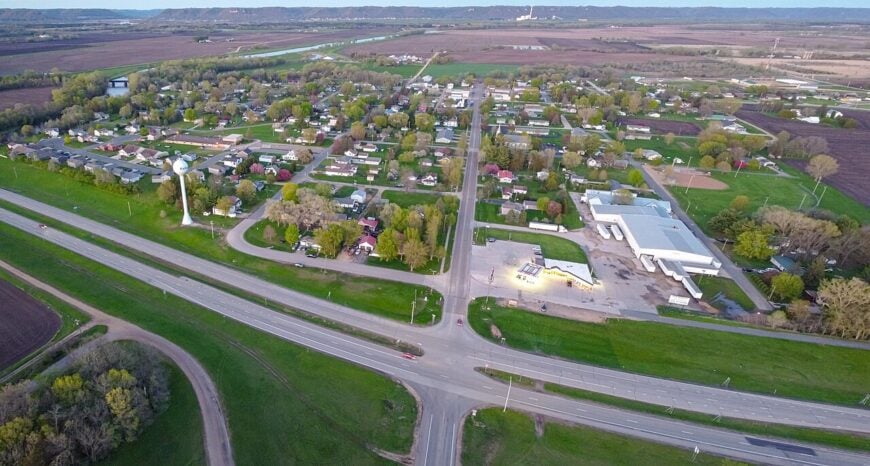
Southeast Minnesota remains shaded by limestone cliffs, braided rivers, and rolling prairie that most travelers only glimpse from the interstate. Venture onto the backroads and a string of hamlets appears, each quietly minding its own business behind bluffs, inside hidden valleys, or along sleepy river bends.
These towns may be small, yet each offers inviting trails, family cafés, and porch-light hospitality that reward anyone willing to wander. Many have populations smaller than a big-city apartment building, while their histories stretch to sawmills, rail sidings, and river ports that long ago slipped off the commercial map.
We gathered the following twenty five communities to show how seclusion can feel comforting rather than lonely, a place where night skies stay dark and neighbors still swap rhubarb over the fence. Pack a thermos, slow your speed, and enjoy the hush that settles over Minnesota’s Driftless corner.
25. Highland – Hidden Hamlet on the Hilltop Divide
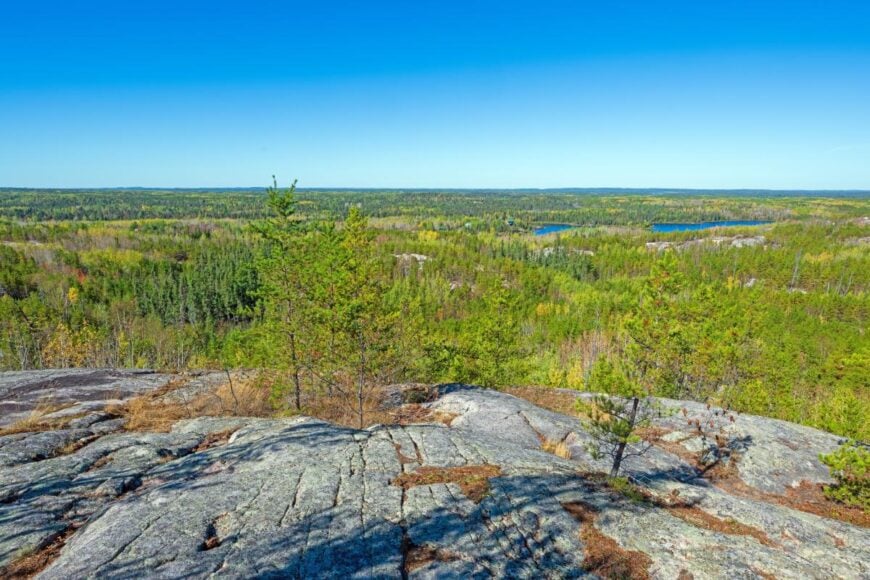
Highland rests quietly in Lake County, about sixteen miles north of Two Harbors, surrounded by dense forest and tucked beside Highland Lake, with only narrow county roads leading in. With just around twenty residents and no commercial center, it feels more like a clearing in the woods than a town.
The air smells of pine and lake mist, and mornings begin with birdsong instead of engines. Visitors might hike lakeside trails, paddle across Highland Lake, photograph quiet shorelines, or picnic where wildflowers bloom.
There’s no industry here—just cabins, a small chapel, and a few who come seeking solitude. Life moves with the rhythm of wind and light, not clocks. It’s the kind of place that reminds you how peaceful the world can be when it’s left untouched.
Where is Highland?
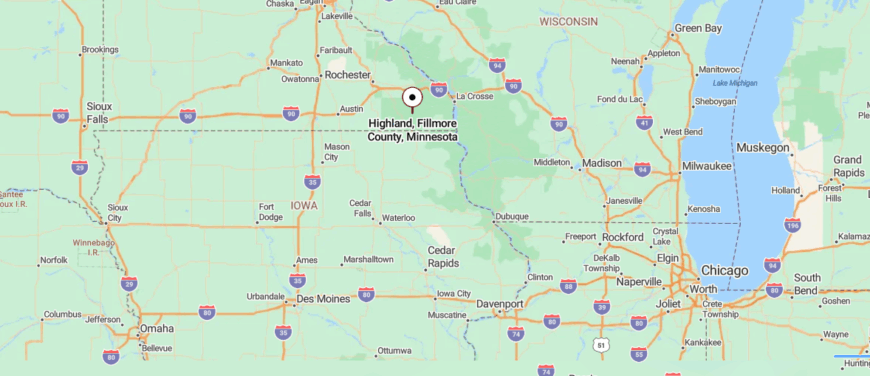
Highland, Minnesota is a quiet unincorporated community in Lake County, tucked into the forested hills about 16 miles north of Two Harbors. It sits near the junction of County Road 14 and Highland Lake Road, surrounded by dense woods and small lakes above the Lake Superior shoreline.
The drive winds through remote stretches of pine and birch, gradually climbing into higher country. Highland feels far from the rush—elevated, still, and gently held in the quiet of northern Minnesota’s backroads.
24. New Hartford – Hollow-Floor Hamlet with No Stop Signs
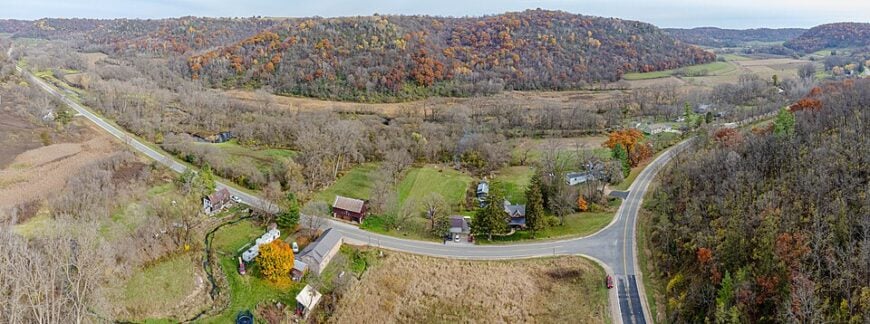
New Hartford lies quietly off the beaten path in Winona County, reached only by winding county roads and surrounded by rolling farmland and wooded bluffs rather than any major highway.
With just a few homes, a historic church, and wide fields that stretch toward the Mississippi River valley, it feels more like a peaceful interlude than a town. The air smells of earth and prairie grass, and the morning light arrives with the song of meadowlarks rather than traffic.
Visitors might stroll past the old schoolhouse, fish in a nearby creek, explore hiking trails through bluff woods, or pause at a roadside farmstand for fresh seasonal produce. Farming anchors the local pace—generations tending fields with care and rhythm. Life here moves gently, shaped by light, wind, and the turn of seasons.
Where is New Hartford?

New Hartford, Minnesota is a small unincorporated community tucked into New Hartford Township in Winona County, southeastern Minnesota. Pine Creek—one of the tributaries feeding into the Mississippi River—flows softly through the area, lending it a quietly rippling character.
You reach New Hartford by county roads that wind through rolling farmland and gentle woodland hollows, gradually descending into the creek valley where the settlement appears. It feels softly isolated—close enough to drift into, yet remote enough that the murmurs of water and trees seem to slow time.
23. Pilot Mound – Prairie Hamlet Beneath Wind Turbines
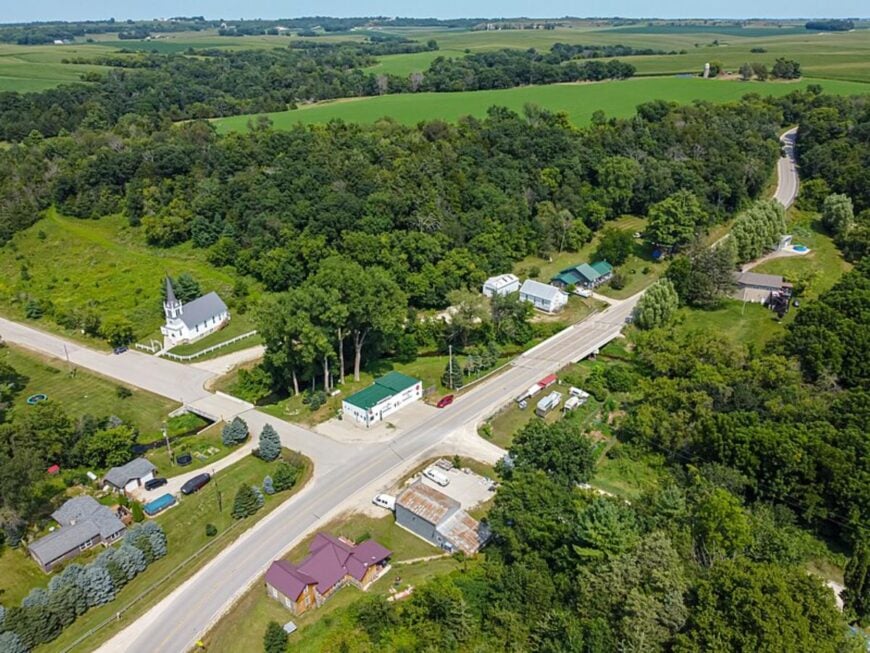
Pilot Mound lies quietly in central Minnesota, nestled off gentle county roads between rolling fields and wooded edges far from any highway bustle. With just a few homes and a small church steeple rising above prairie grass, it feels more like a hidden glade than a town.
The air smells of fresh hay and earth, and soft breezes carry birdcalls where engine hums might otherwise be. Visitors might walk prairie paths beneath big sky, fish the quiet stretch of a nearby creek, explore relics of early settlement, or pause beside private farm stands offering fresh produce and stories.
Farming shapes the daily rhythm here, with traditions handed down through generations. Days unfold slowly, measured by sunlight and seasons rather than clocks. It’s the kind of place that reminds you how gently calm the world can be when you’re tucked into land and stillness.
Where is Pilot Mound?
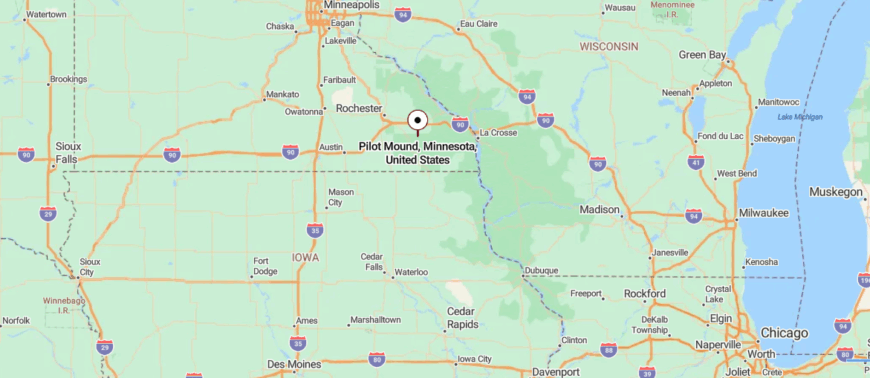
Pilot Mound is a tiny hamlet nestled in Pilot Mound Township, Fillmore County, Minnesota, named for a modest hill that once guided early settlers across the region. It lies several miles northeast of Lanesboro, accessible via quiet county roads that weave through rolling farmland and wooded hollows before reaching the loose cluster of homes near the summit.
The road gently climbs and curves, opening into a landscape of open fields and scattered pines, where the air holds the stillness of rural Minnesota. Pilot Mound feels softly isolated—easy to reach if you know where you’re going, yet distant enough that time seems to pause atop that gentle rise.
22. Bethany – Valley Village with a View
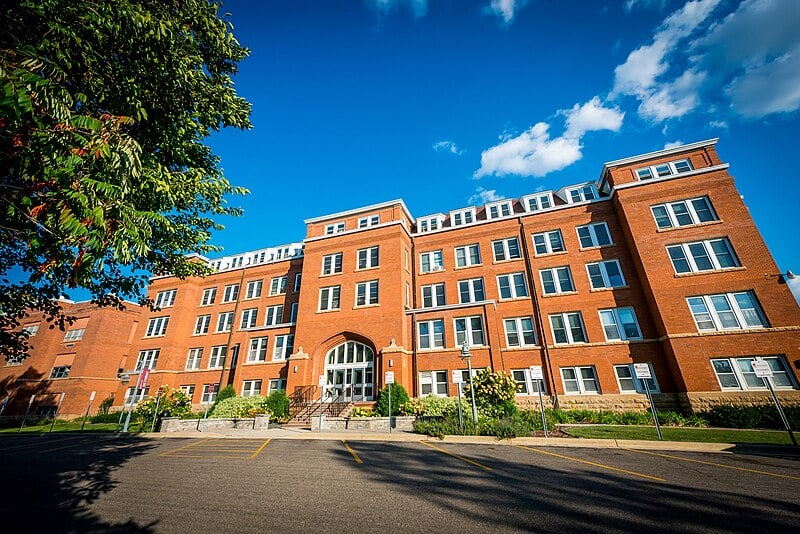
Bethany lies quietly in Sibley County, tucked off winding gravel lanes and surrounded by farmland and pockets of woodland that buffer it from any highway hum. With just a handful of residences and a historic church steeple against open sky, it feels less like a town and more like a hidden breath in the countryside.
The air carries the faint scent of tilled earth and prairie grasses, and mornings begin with songbirds rather than traffic. Visitors might walk old farm roads lined with wildflowers, fish in a shaded creek, explore the simple charm of the century‑old church, or stop at a roadside stand for fresh local honey and friendly conversation.
Farming sustains the rhythm here—generations tending fields close to the land and each other. Days pass gently, guided by light and seasons rather than clocks. It’s the kind of place that reminds you how peaceful life can become when the world softens its edges.
Where is Bethany?

Bethany, Minnesota is an unincorporated community in Norton Township, Winona County, set among the rolling farmland of southeastern Minnesota. It lies near the junction of County Roads 20 and 27, just a few miles northwest of Lewiston.
You reach it by quiet rural roads that wind through fields and woods before arriving at the small, historic settlement. Bethany feels gently removed—close enough to find, yet distant enough to hold onto its quiet past.
21. Freeburg – Driftless Hollow with Swiss Roots
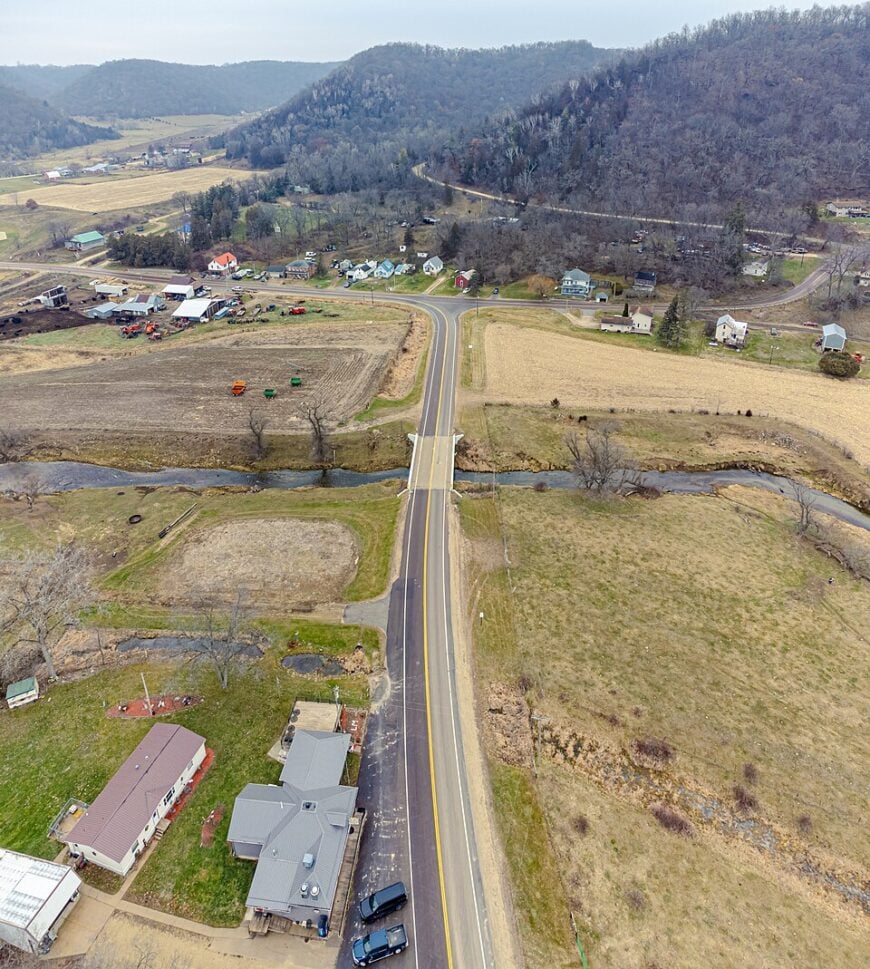
Freeburg lies quietly off the map in rural Minnesota, reached only by narrow county roads weaving through cornfields and small woodlots, far from any major highway or bustle. With just a scattering of homes, a modest church, and wide-open skies above, it feels less like a town and more like a peaceful breath in the landscape.
The air carries the faint scent of freshly turned soil and prairie grasses, and mornings begin with songbirds instead of engines. Visitors might walk winding farm lanes edged with wildflowers, fish in a nearby creek, explore the historic church, or stop at a local stand for seasonal produce and warm conversation.
Farming quietly anchors daily life—families working land passed down for generations. Days here unfold slowly, measured by sunlight and seasons instead of schedules. It’s the kind of place that reminds you how deeply calm the world can be when stillness is the natural setting.
Where is Freeburg?
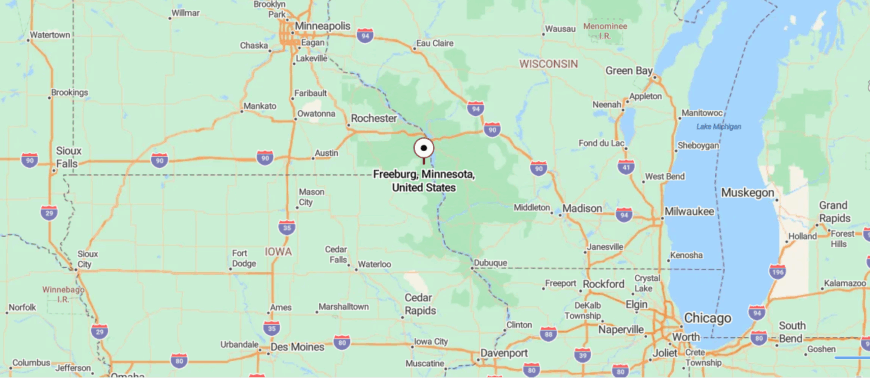
Freeburg, Minnesota is a small unincorporated community in Houston County, southeastern Minnesota, nestled along Crooked Creek at an elevation of about 686 ft. Originally settled by German immigrants and named after Freiburg, Germany, it maintained a post office from 1858 until 1947.
You reach Freeburg by county roads that wind through farmland and wooded creek bottoms, gradually descending into the quiet settlement where the creek gently ripples beside old homes. It feels softly secluded—close enough for a detour off the map, yet distant enough that the hush of the valley slows time.
20. Troy – Quiet Hollow Along a Trout Stream
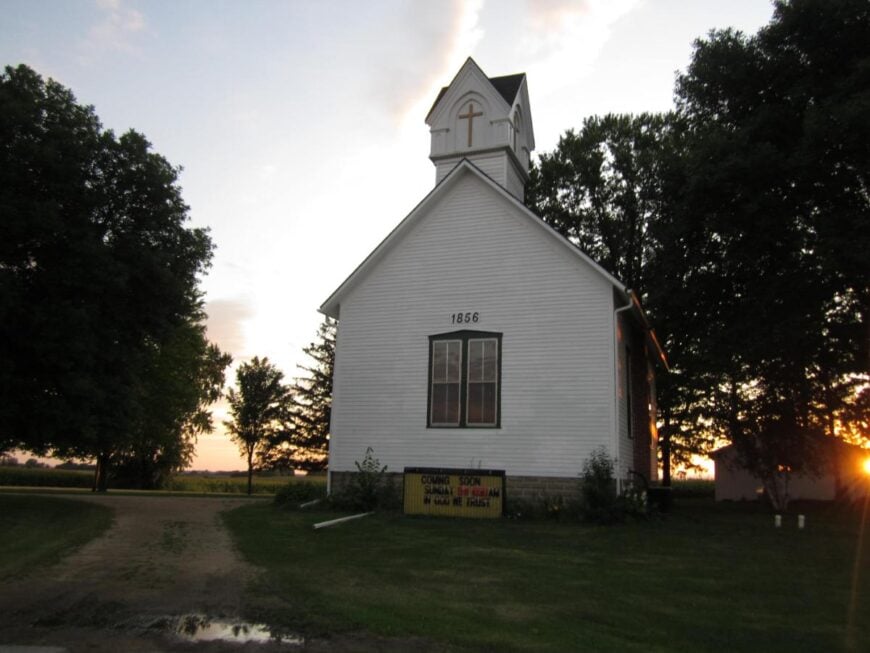
Troy rests quietly in Winona County, nestled off winding backroads amid rolling fields and wooded bluffs that feel miles from any highway hum. With only a few homes clustered near a weathered church and no storefronts to speak of, it feels more like a gentle pause in the countryside than a true town.
The air carries the scent of wild grasses and tilled earth, and dawn unfolds with the song of meadowlarks rather than engine noise. Visitors might wander scenic country lanes, fish in a nearby creek shaded by oak trees, explore old stone structures hidden behind farm fences, or browse seasonal produce at a roadside stand hosted by locals.
Farming remains the quiet heartbeat here—fields tended with care and stories handed down through generations. Daily life flows with the rhythm of seasons and sunlight, not schedules. It’s the kind of place that reminds you how deeply peace can settle when the world holds its breath just long enough.
Where is Troy?
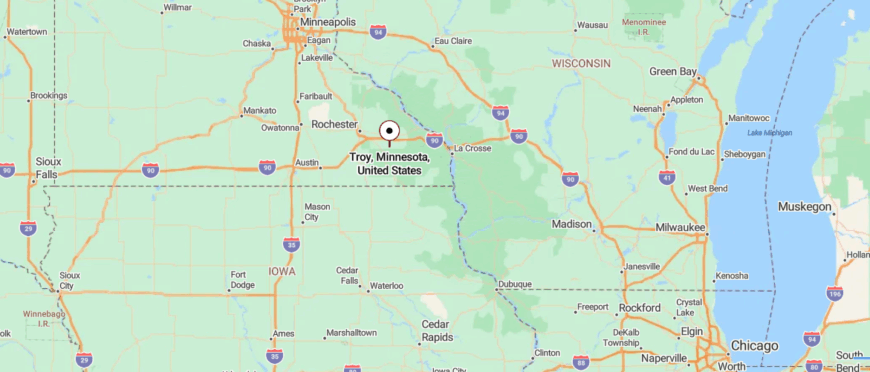
Troy, Minnesota is an unincorporated community in Saratoga Township, Winona County, in southeastern Minnesota. It lies at the junction of State Highway 74 and County Road 6, with Trout Run Creek flowing through the area.
You reach Troy via quiet county and state roads, passing through rolling farmland and woodlands before arriving at the small rural settlement. Troy feels gently tucked away—close enough to find when you mean to arrive, yet distant enough that the hush of creek and field seems to pause time.
19. Ridgeway – Summit Stop with Church Bells and Pines
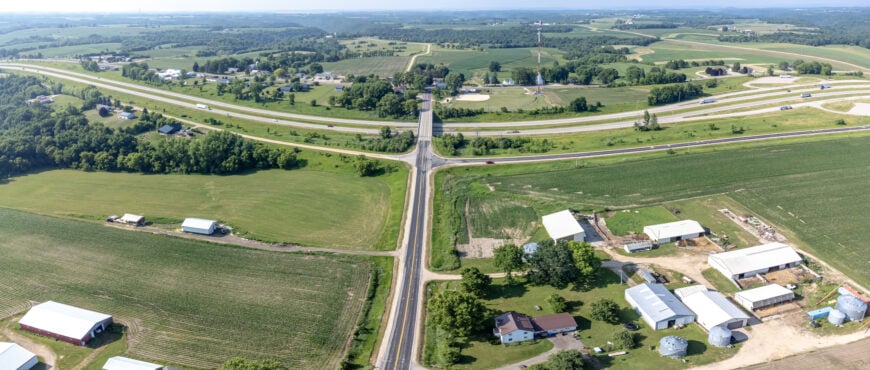
Ridgeway lies gently off the beaten path in Houston County, surrounded by rolling hills, oak groves, and country lanes that wind away from any highway hum. With only a few homes, a small chapel, and fields that stretch into the horizon, it feels less like a town and more like a quiet nook carved out of the landscape.
The air smells faintly of prairie grass and damp soil, and mornings begin with birdsong instead of engines. Visitors might wander shaded trails through historic ridgelines, fish a peaceful stretch of the Root River, explore century-old stone bridges still standing over small creeks, or pause at a roadside stand for fresh berries and neighborly conversation.
Farming remains the gentle pulse here—generations tending soil, tending stories. Days unfold at the pace of sunlight and seasons rather than schedules. It’s the kind of place that reminds you how deeply peace can settle when silence becomes the scenery.
Where is Ridgeway?
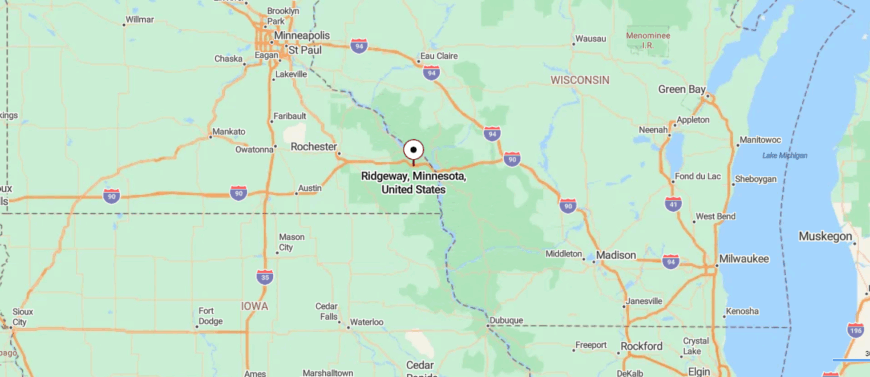
Ridgeway, Minnesota is a small unincorporated community in Pleasant Hill Township, Winona County, southeastern Minnesota. It sits near the junction of Winona County Roads 11, 12, and 104, not far from Interstate 90 and State Highway 76.
The drive follows rural backroads through the Driftless Area’s rolling hills and creek valleys until the village emerges in a quiet clearing. Ridgeway feels gently tucked away—close enough to reach, yet distant enough that its quiet wooded hollows seem to hold time still.
18. Cherry Grove – Wildflower Crossing of Fields and Forest
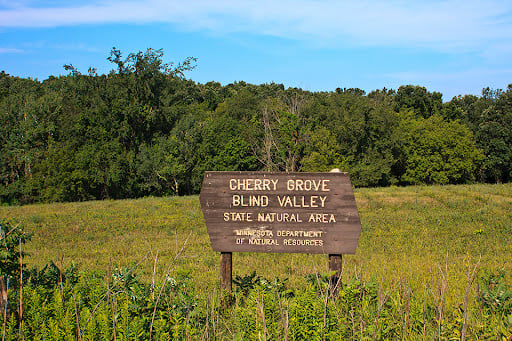
Cherry Grove lies quietly in Olmsted County, tucked down gravel backroads and buffered by small woodlots and fields rather than bustling highways. With just a few clustered homes, an old country church, and wide-open skies, it feels more like a hidden memory than a destination.
The air tastes faintly of cherry blossoms and tilled earth, and mornings arrive with bird chatter instead of traffic noise. Visitors might stroll along creekside paths shaded by oak groves, fish in the quiet flow of the Zumbro River, explore a historic schoolhouse fondly preserved by locals, or linger at a roadside stand selling homemade jam and fresh baked goods.
Farming softly anchors the rhythm here—families tending the land with care and patience. Days pass gently, shaped by the light and the turning of seasons rather than rush or noise. It’s the kind of place that reminds you how deeply peace can settle when a town chooses stillness over hurry.
Where is Cherry Grove?
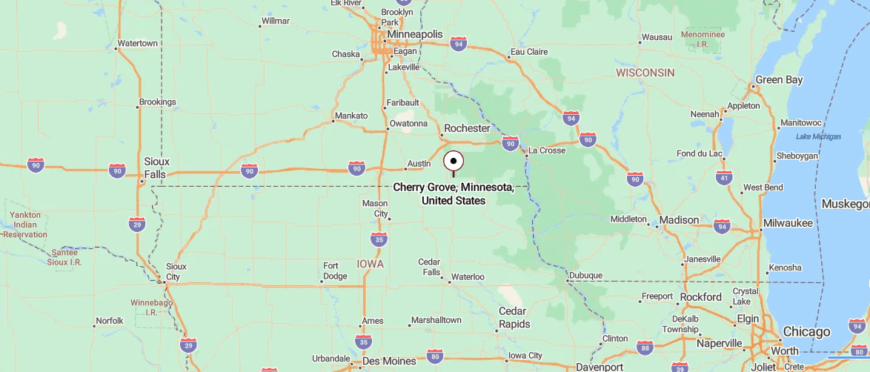
Cherry Grove, Minnesota is a small unincorporated community in Fillmore County, situated about 9 miles south of Wykoff at the junction of County Road 5 and 160th Street, just west of Forestville Mystery Cave State Park . It lies roughly 15 miles southwest of Preston and 12 miles southeast of Spring Valley, set amid quiet farmland and gentle creek valleys near U.S. Highway 63.
You reach it by following County Road 5 and adjacent gravel lanes, traveling through open fields, wooded hollows, and the peaceful backdrop of southeastern Minnesota’s rural driftless terrain. Cherry Grove feels softly forgotten—close enough to find, yet remote enough that time stretches out in the hush of fields and trees.
17. Beaver – Forested Notch with a Ghost Town Feel
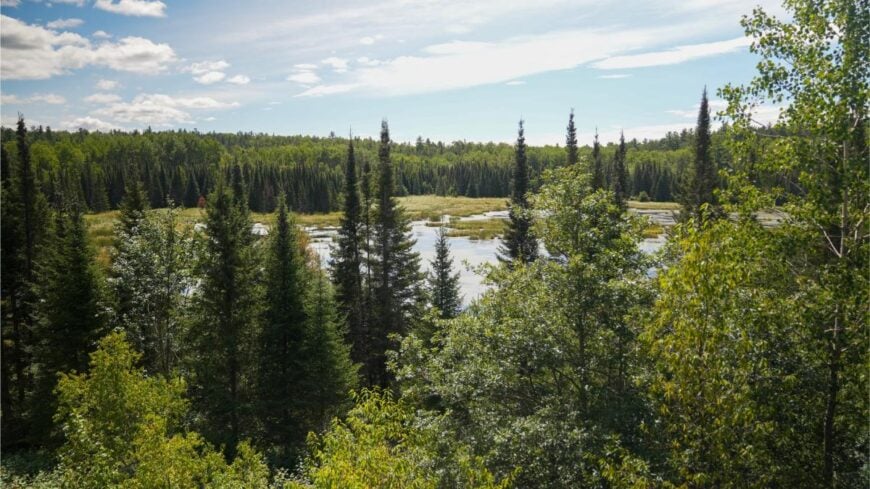
Beaver sits quietly in Winona County, tucked where State Highway 74 meets County Road 30 and hemmed in by the driftless hills and flowing waters of Beaver Creek and the Whitewater River . It feels tucked away—a small cluster of homes clustered beside a creek, with no storefronts, no stoplights, and nothing between you and river‑worn silence.
The air carries the scent of damp creek mud and warm prairie grasses, and morning mist settles soft above the water before any engine breaks the hush. A visitor might fish along Beaver Creek, follow the wooded shoreline walking paths, paddle where the creek feeds into the river, or explore nearby Whitewater State Park’s scenic trails just a short drive away.
Farming quietly anchors local life—small family plots that echo generations of stewardship deep in the valley. Days pass slowly here, shaped by light through the leaves and water’s gentle passage. It’s the kind of place that reminds you how peaceful the world can feel when nature owns most of the view.
Where is Beaver?
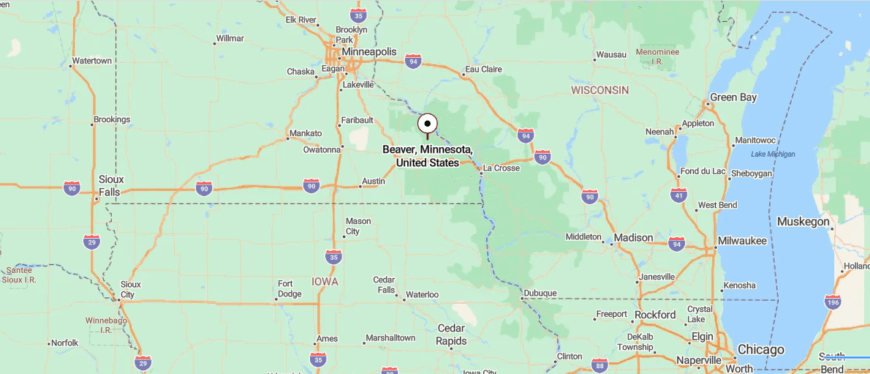
Beaver, Minnesota is a quiet unincorporated community in Whitewater Township, Winona County, near the junction of State Highway 74 and County Road 30. Nestled where Beaver Creek meets the Whitewater River, it was settled in 1854 and once had a mill, store, and post office.
Over time, erosion and flooding reclaimed much of the original town. Today, Beaver feels gently hidden—reachable by winding roads, yet hushed by nature and time.
16. Bratsberg – Ridge Hamlet with a View Toward Norway
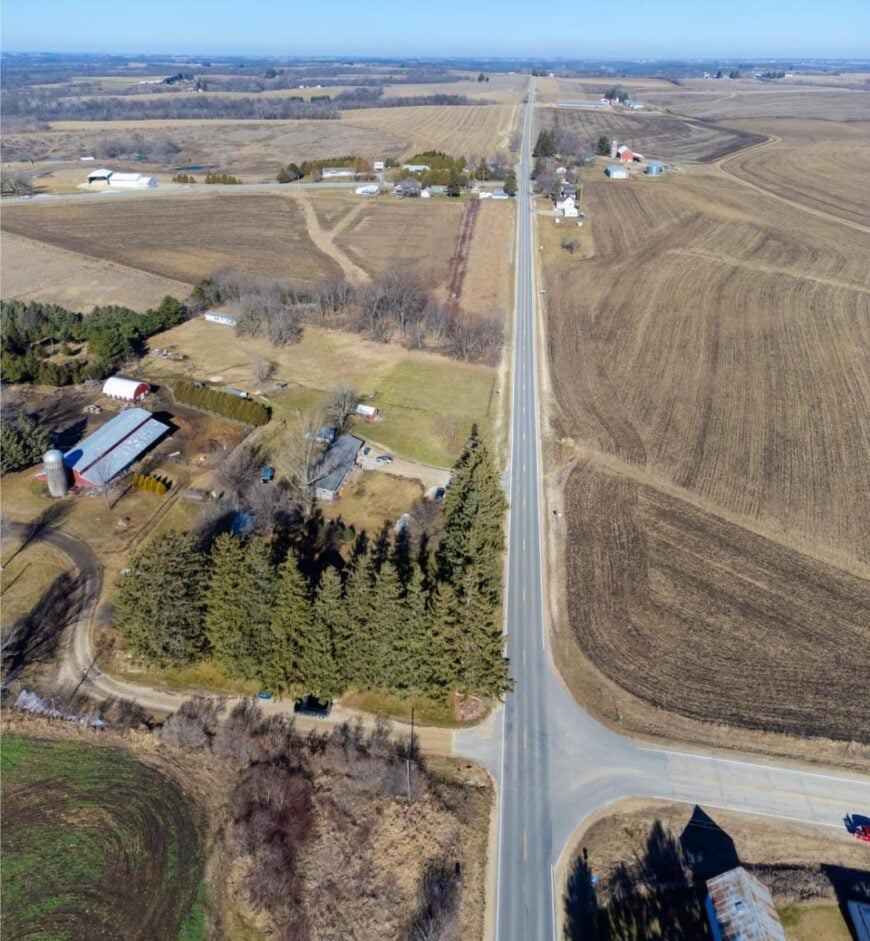
Bratsberg rests quietly in Houston County, tucked between bluffs and farmland and reached only by winding gravel roads that slip away from the nearest highway. With just a few homes and a historic church, it feels more like a quiet pause in the countryside than a town.
The air smells of tilled earth and woodsmoke, and mornings begin with birdsong instead of traffic. Visitors might walk rural lanes, fish in a nearby creek, explore old farm buildings, or stop at a roadside stand for fresh baked goods. Farming anchors daily life—steady, seasonal, and close to the land.
Time moves gently here, shaped by sunlight and soil. It’s the kind of place that reminds you how still the world can be when nothing needs to change.
Where is Bratsberg?

Bratsberg, Minnesota is a small unincorporated community in Norway Township, Fillmore County, in southeastern Minnesota. Located about 5 miles south of Rushford and just west of Lanesboro, it sits at an elevation of 1,214 feet with rural roads leading through farmland and wooded hills.
Founded in 1862 and named after a Norwegian county, it once had a post office that closed in 1907. Today, Bratsberg feels quietly tucked away—easy to find, yet distant enough for time to slow among the trees and fields.
15. Etna – Forgotten Junction by the State Line
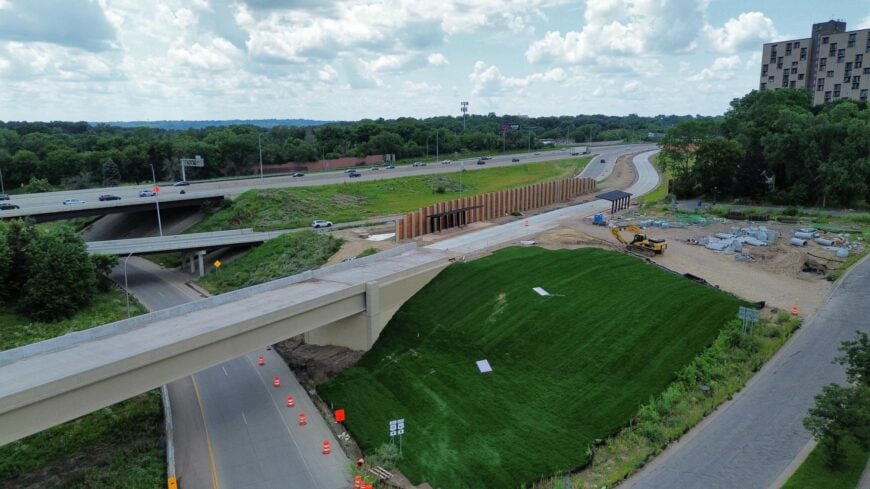
Etna lies soft in the rolling fields of Winona County, hidden at the bend of a gravel road and hemmed in by prairie grass and scattered oak groves—far from any highway or urban center. With just a handful of homes and a small country church steeple piercing the horizon, it feels more like a quiet whisper than a town.
The air smells of dew-tipped grass and fresh earth, and sunrise arrives on the hum of meadowlarks instead of engines. Visitors might stroll country lanes lined with wildflowers, fish in nearby creek bends, explore the rural cemetery shaded by ancient trees, or pause at a neighbor’s porch for homemade jam and quiet conversation.
Farming remains the gentle pulse here—families cultivating their land with care and continuity. Daylight shapes life more than calendars—sunrise to sunset, season to season. It’s the kind of place that reminds you how still and meaningful the world becomes when you let it breathe.
Where is Etna?

Etna, Minnesota is a small unincorporated community nestled in Bloomfield Township, Fillmore County, in southeastern Minnesota. Located about 8 miles southeast of Spring Valley, at the junction of County Road 14 and 153rd Avenue, it’s surrounded by gently rolling farmland and creek valleys—including Etna Creek and the South Branch Root River that flow nearby.
You reach Etna via quiet county roads off U.S. Highway 63, tracing a route through fields, groves, and stream-crossed terrain until the settlement quietly appears. Etna feels softly removed—easy enough to find by purpose, yet distant enough that the gentle creeks and wooded hollows seem to pause time.
14. Saratoga – Woodland Clearing with Trail Access
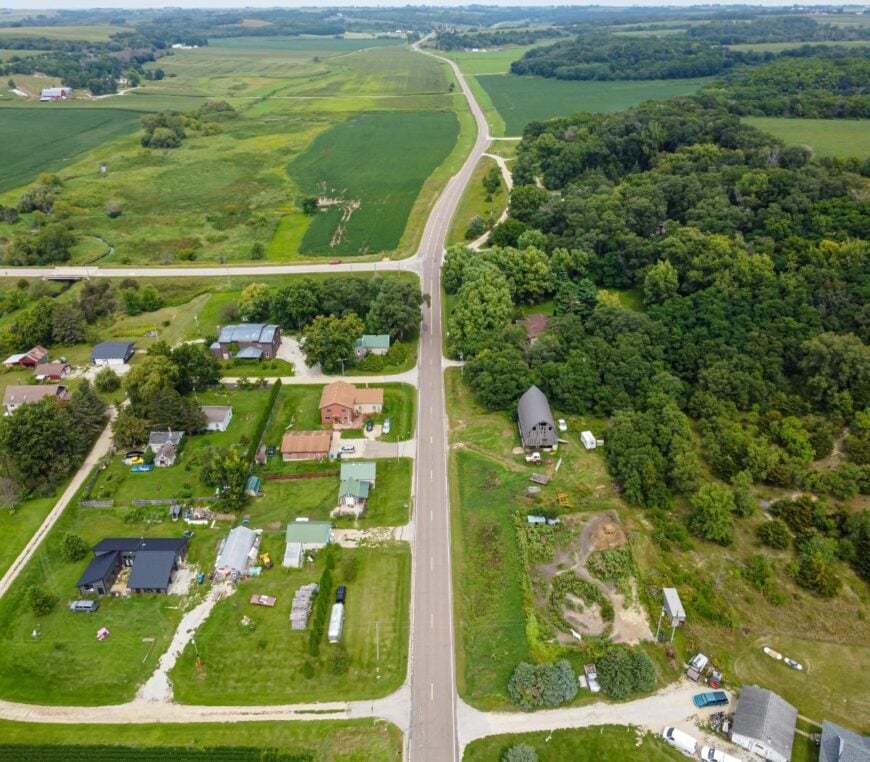
Saratoga lies quietly in Winona County, tucked along a gravel lane and surrounded by open prairie, woods, and gently rolling hills far from highway bustle. With only a handful of homes and an old country church steeple against the sky, it feels more like a hidden pause in the landscape than a true town.
The air tastes faintly of grass and earth, and dawn arrives with meadowlark song instead of traffic. Visitors might fish in a nearby creek, stroll rustic trails shaded by oaks, explore the historic churchyard, or enjoy fresh berries from a roadside stand hosted by a neighbor.
Farming quietly anchors life here—rising seasonally and passed through generations. Days pass gently, shaped by light and soil—not clocks. It’s the kind of place that reminds you how meaningful silence can feel when it’s chosen, not enforced.
Where is Saratoga?
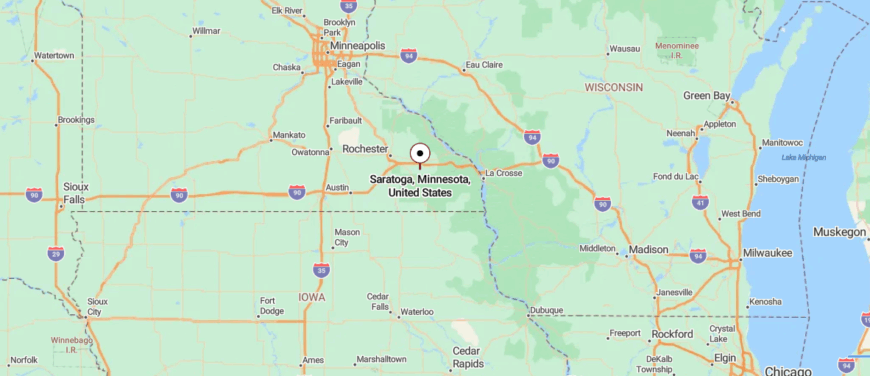
Saratoga, Minnesota is an unincorporated community located in Saratoga Township, Winona County, in southeastern Minnesota. It sits near the junction of State Highway 74 and County Road 10, just south of St. Charles, with Trout Run Creek flowing through the settlement.
You travel there via MN‑74 or pastoral county roads that thread through rolling farmland and creek valleys, gradually stepping away from busier routes into quiet countryside. The roads dip into wooded hollows as the creek murmurs nearby, guiding you to the modest cluster of homes and a sense of stillness.
13. York – Ridge Community with a Big Sky Feel

York lies quietly in Faribault County, tucked along gravel lanes and bordered by gentle farmland and low oak bluffs—far from any main highway or city hum. With just a few homes and a historic chapel, it feels more like a pastoral pause than a proper town.
The air smells faintly of earth and prairie grass, and mornings bloom with meadowlark song instead of engines. Visitors might stroll country lanes under big sky, fish a shaded creek bend, explore hidden trails near oak ridges, or chat with neighbors at a roadside stand offering fresh produce.
Farming anchors daily life here—tended with care across generations. Days unfold slowly, shaped by light and seasons rather than clocks. It’s the kind of place that reminds you how still the world can feel when you let nature set the pace.
Where is York?
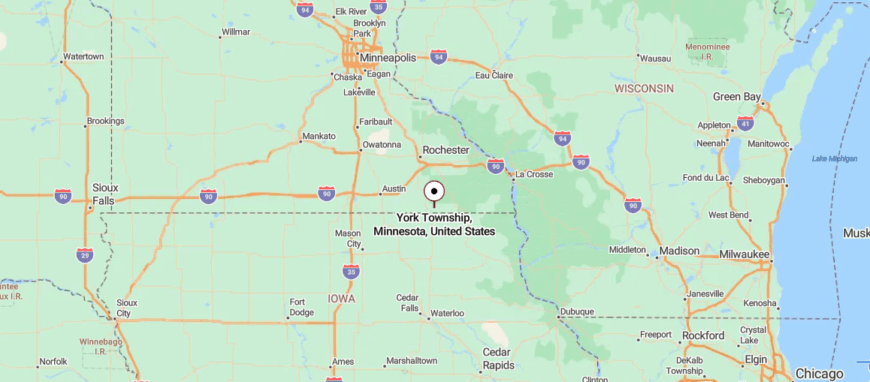
York, Minnesota is a quiet unincorporated community nestled in Fillmore County, located within York Township in southeastern Minnesota. Situated at an elevation of about 1,319 feet, it lies in the gently rolling Driftless landscape and is reached via rural county roads that thread through farmland and wooded hollows.
The community is roughly several miles south of nearby towns such as Wykoff and Preston, placing it in a region where small farms, streams, and wooded hills abound . Arriving by purpose along quiet lanes descending into York Township, the settlement emerges softly amid pastures and creek valleys.
12. Altura – Sleepy Valley Floor Near the Whitewater
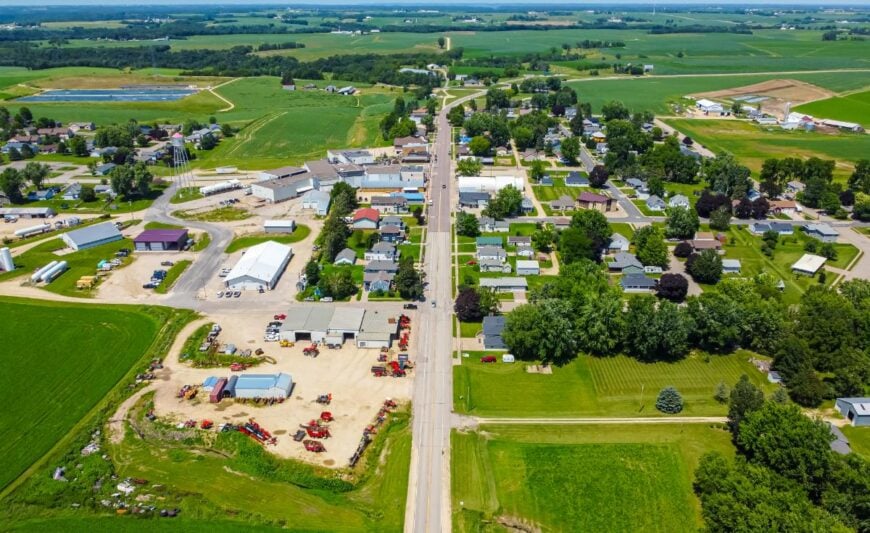
Altura lies quietly in Fillmore County’s rolling hills, tucked along gravel roads that wind away from any highway hustle, where oak and maple groves cradle its few homes. The town feels more like a hidden glade than a settlement—just a small cluster of residences and a chapel steeple peeking through trees.
Mornings arrive with meadowlark song and the scent of damp earth instead of engines. Visitors might walk winding country lanes, fish in a peaceful creek, explore roadside fields edged in wildflowers, or chat with neighbors at a farmstand offering seasonal produce and stories.
Farming still sustains life here—hands that have worked the land for generations, guided by sun and soil. Days drift by gently, paced by light and quiet. It’s the kind of place that reminds you how deeply serene the world becomes when you let it breathe.
Where is Altura?

Altura, Minnesota is a small city in Winona County, in southeastern Minnesota. Located at about 1,188 feet elevation, it spans nearly 3 square miles with a population of around 470 residents as of the 2020 census.
You’ll find Altura off State Highway 74, just east of Elba, reached via country roads that trace open fields and wooded hollows into a friendly rural town. Whitewater State Park lies nearby, offering hiking trails and limestone bluffs that give the area its scenic backdrop
11.Haverhill – Hidden Ridge Settlement with a Prairie View

Haverhill rests quietly in rural Fillmore County, tucked down county roads that drift through gentle prairie and oak woodlands far from any major highway. With just a few homes, an old chapel, and wide fields stretching under open sky, it feels less like a town and more like a place the world forgot to hurry.
The air smells of grass and mown hay, and dawn arrives with meadowlark song and dew‑kissed earth before any engine hum. Visitors might stroll shadowed farm lanes lined with wildflowers, fish in a nearby creek bend, explore an old church and its simple graveyard, or stop by a local farmstand for fresh produce and conversation.
Farming anchors the rhythm here—families tending their land with care and seasons in mind. Days unfold gently, shaped by light and soil rather than schedules. It’s the kind of place that reminds you how quietly expansive life can be when nature sets the pace.
Where is Haverhill?

Haverhill Township sits about ten miles northeast of Rochester in Olmsted County, spanning roughly thirty-three square miles of gently rolling farmland, oak savanna and small woodlots. Its northern boundary touches Wabasha County, while to the east lie stretches of the Zumbro River valley. There is no central “downtown” here—just a network of township roads weaving between family farms and patches of restored prairie.
You’ll reach Haverhill by following County Road 9 north from Highway 52, then turning onto County Road 16 to cross fields and creek bottoms before dipping into wooded hollows. Scattered farmsteads and a handful of historic schoolhouses mark the landscape rather than a clustered settlement, giving drivers the sense of passing through countryside more than visiting a town.
10. Whalan – Tiny Trailhead on the Root River
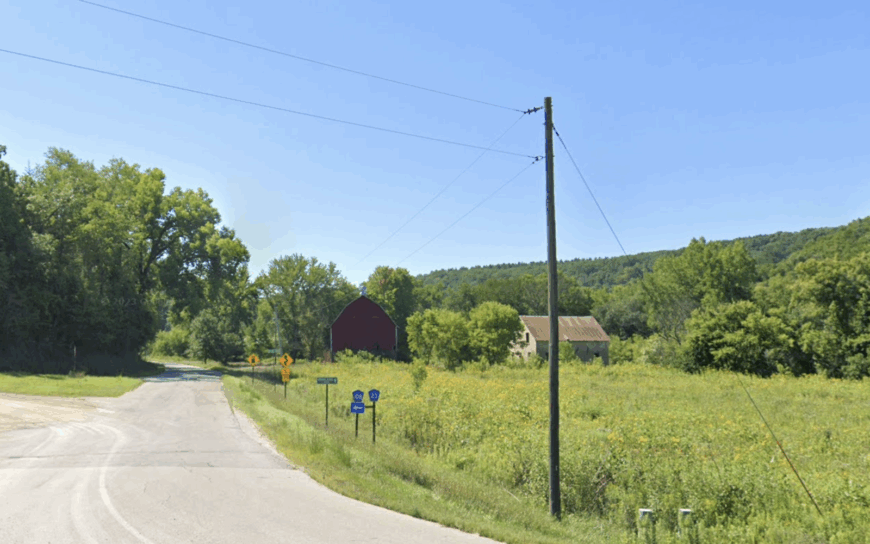
Roughly 65 residents keep Whalan humming along a two-block main street that seems frozen in 1910. Cyclists roll in on the Root River State Trail for slices of meringue at Aroma Pie Shoppe, while anglers drop below the old steel trestle in search of brown trout.
A handful of vacation rentals and the annual Stand Still Parade, where floats pause so spectators can stroll around them, supply the town’s modest tourism income. Farming on the plateau above and seasonal trail traffic form the primary economic base, leaving little industry to disturb the quiet.
Sheer limestone bluffs rise directly behind the storefronts, blocking highway noise and cell coverage in equal measure, which helps cement Whalan’s hideaway feeling. After sunset the only glow often comes from porch bulbs and the Milky Way arching over the Root River valley.
Where is Whalan?
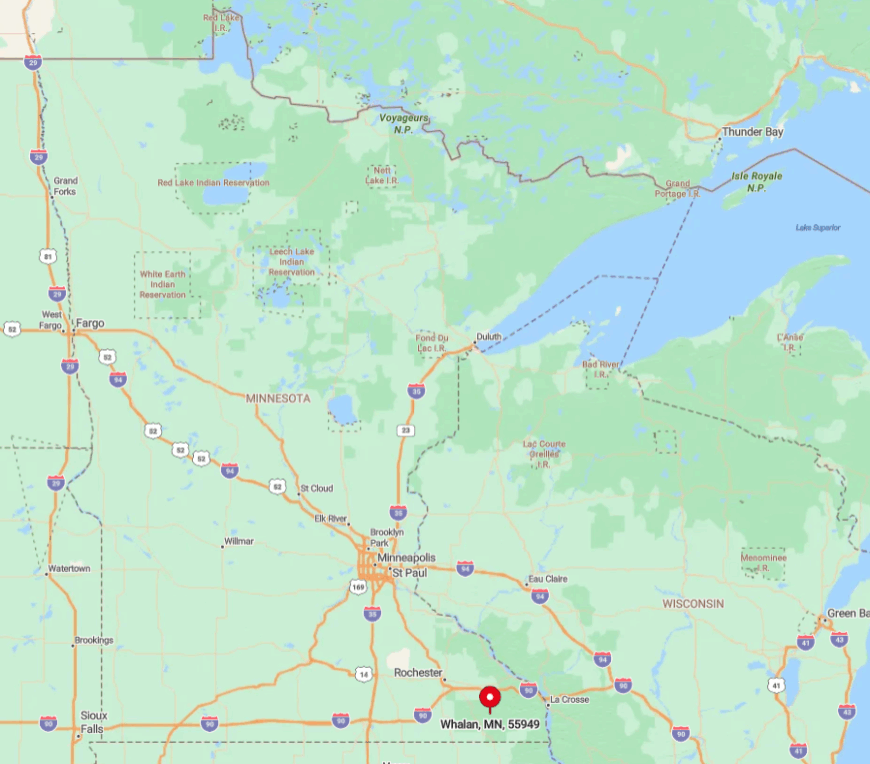
Whalan rests in Fillmore County about five miles east of Lanesboro along County Road 16. The community sits in a deep coulee carved by the Root River, and those enclosing hills explain why it feels worlds apart despite being only an hour from Rochester.
Drivers must follow a winding county highway or arrive by bicycle on the state trail, routes that discourage hurried traffic. Because there is no direct interstate access, guests find themselves willingly slowing to the river’s pace long before they reach the village limits.
9. Peterson – Bluff Country Hamlet by the River Bend
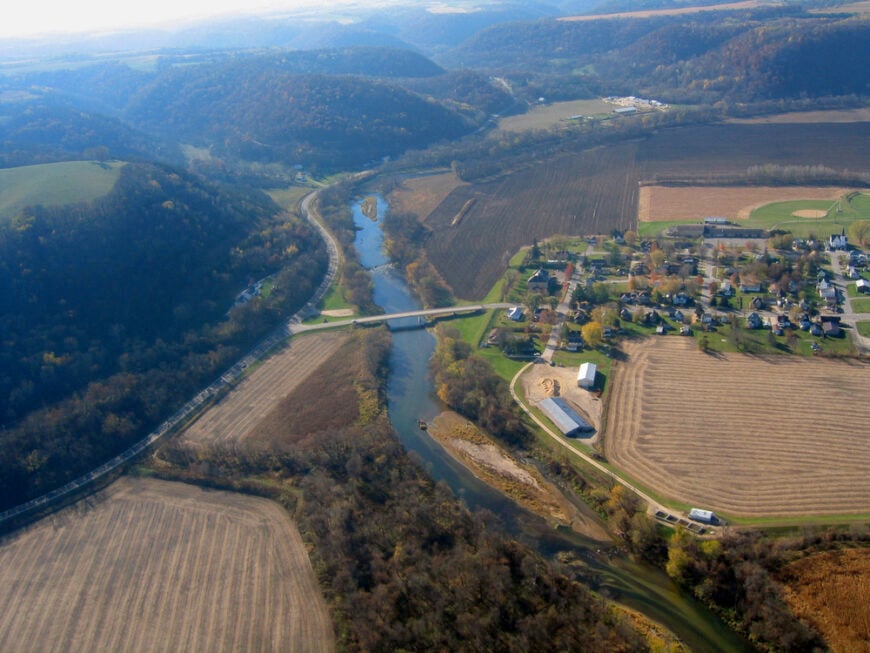
Peterson claims about 200 inhabitants who wake to fog lifting off a sweeping curve of the Root River. Visitors paddle that same bend, then step inside Burdey’s Café for hotdish or explore the Peterson Station Museum housed in the 1877 depot.
Hayfields, small dairy farms, and a cluster of riverfront cabins provide most local employment, with a few residents commuting to Lewiston or Rushford. The town’s single grain elevator, decommissioned yet still standing, nods to an agricultural past that never grew large enough to attract heavy industry.
Sky-scraping bluffs crowd both banks of the river, muting road noise and limiting buildable acreage, which keeps the settlement small. Nights remain so still that crickets and the river’s sigh are often the loudest sounds.
Where is Peterson?

Peterson lies along Minnesota Highway 16, thirty miles east of Interstate 90, tucked between the Driftless escarpments of Fillmore County. Steep walls and river meanders force the highway to slow and curve, ensuring traffic drifts rather than blasts through town.
Rochester travelers exit onto County Road 25 then weave south into the valley, while cyclists roll in on the same Root River State Trail that links to Whalan. Those natural barriers grant Peterson its unhurried atmosphere and keep development at bay.
8. Minneiska – Mississippi Backwaters Outpost
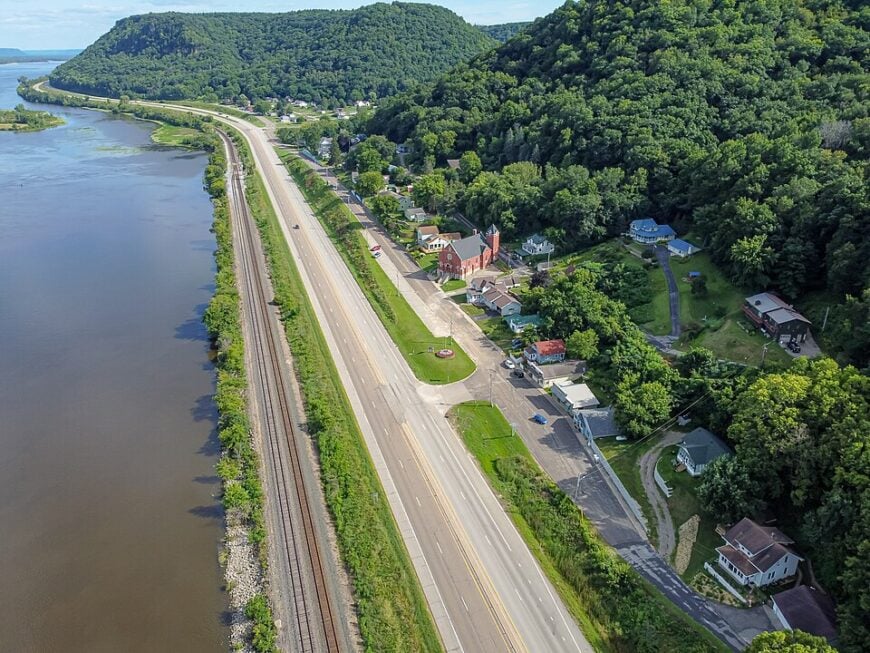
Fewer than 100 people inhabit Minneiska’s slim ribbon of riverfront where boathouses nudge against wooded islands and sandbars. Residents spend weekends casting for walleye, counting migrating pelicans, or steering flat-bottomed boats through maze-like sloughs that shelter turtles and bitterns.
Commercial activity is limited to a seasonal bar-and-grill, a small marina, and grain barges occasionally mooring at an upstream terminal. Barging, river recreation, and a scattering of farm jobs across the highway form the area’s modest livelihood.
Thick floodplain forest and the wide Mississippi backwaters create a natural moat, while Highway 61 skirts just far enough away to muffle passing semis. The result is a shoreline community where dawn mist and distant train whistles are most of the morning chatter.
Where is Minneiska?
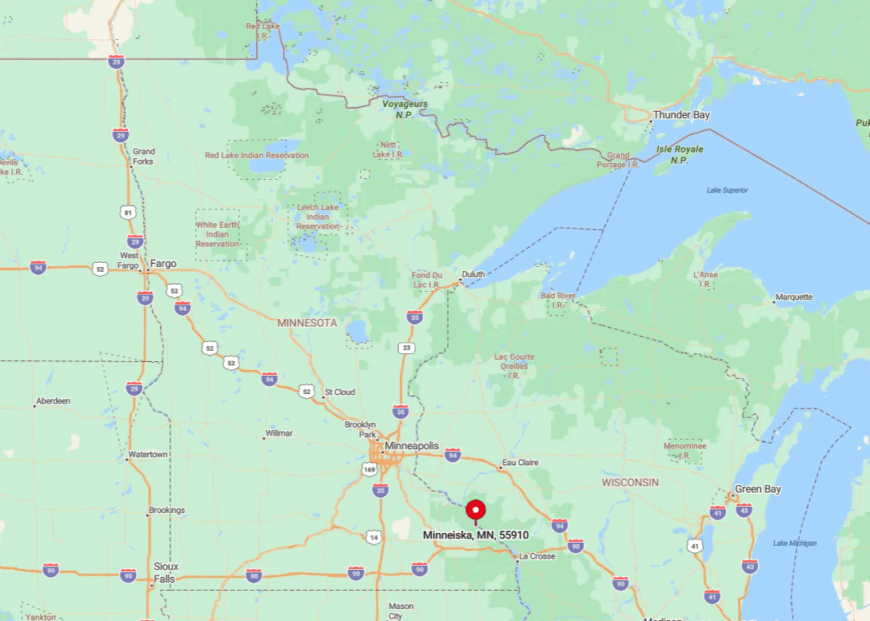
Minneiska sits on the Wabasha-Winona county line at river mile 730, roughly midway between Winona and Lake City. The town occupies a narrow terrace between the Mississippi’s Pool 5A and sheer sandstone bluffs, leaving no room for sprawl.
Drivers reach it by exiting Highway 61 onto County Road 21, which soon dead-ends at the water. Trains, boats, or a winding two-lane road are the only ways in, which helps preserve Minneiska’s tucked-away vibe.
7. Elba – Gateway Village to Whitewater State Park
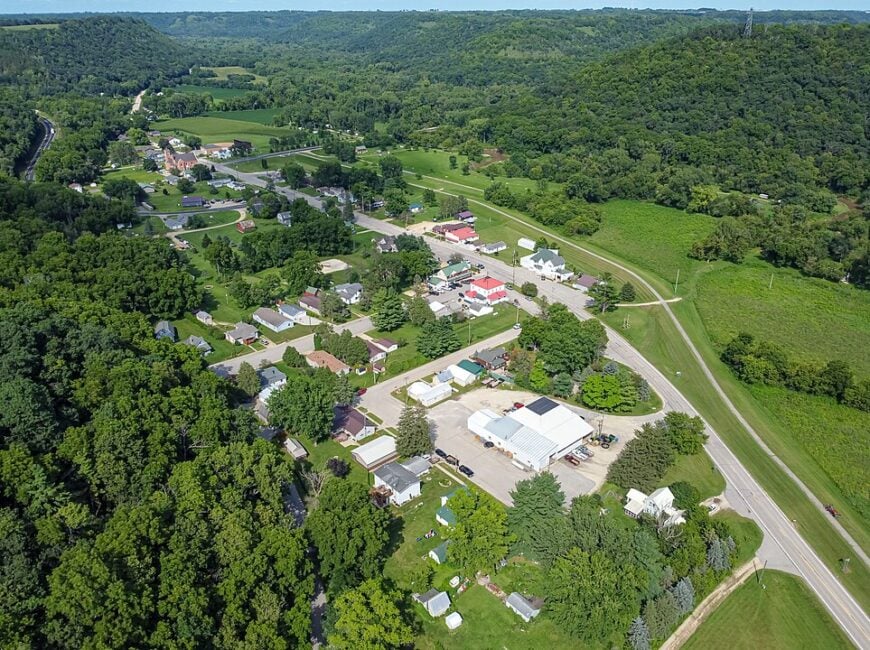
Elba hosts around 160 residents within sight of the 127-foot church steeple that doubles as the village’s informal landmark. Hikers drift through on their way to Whitewater State Park, where the Chimney Rock Trail and Dutton Brook trout pools sit minutes from downtown.
Farming corn and soy atop the surrounding flats, plus park hospitality jobs, supply most local paychecks. No manufacturing or strip malls interrupt the valley’s chorus of birdsong, and cellular reception weakens as soon as the ridges close in.
Elba’s position inside a U-shaped hollow, ringed by 400-foot limestone walls, keeps it visually hidden from anyone who sticks to trunk highways. After dark, only the clap of deer hooves across gravel lanes breaks the quiet.
Where is Elba?
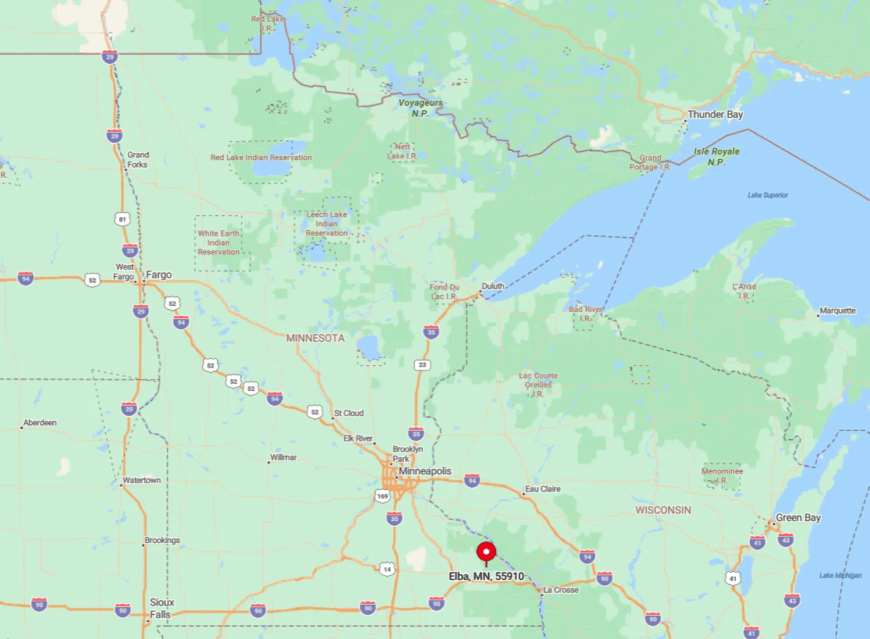
Elba rests along Minnesota Highway 74, the state’s last unpaved trunk highway segment, 25 miles northeast of Rochester. Travelers drop off the plateau on switchbacks and follow the Whitewater River through two miles of gravel before the road returns to pavement at town limits.
Those bends and the lack of a nearby interstate deter heavy traffic. Because Highway 74 dead-ends deep in the state park, most motorists arrive intentionally, not by chance, keeping Elba’s solitude intact.
6. Hammond – Zumbro River Lowland Retreat
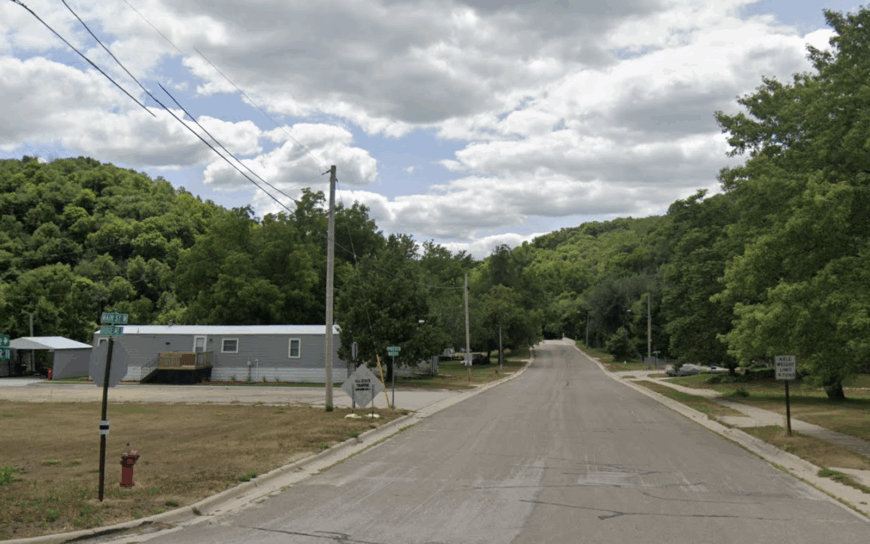
About 130 people call Hammond home, many of whom can launch a kayak from their backyard into the gentle Zumbro River oxbows. Summer days feature leisurely tubing runs, birding along cottonwood groves, and Friday night fish fries at the community hall.
Small farms, part-time river outfitting, and a cooperative grain elevator anchor the local economy while larger employers sit twenty minutes away in Rochester or Plainview.
The village lies outside any four-lane corridor, so the loudest rumble usually comes from tractors crossing Main Street. The river bends twice around Hammond, forming an oxbow buffer that discourages through-traffic and expansive growth. Fog mingling over cut hay fields at dawn seals its off-the-map character.
Where is Hammond?

Hammond is in northern Wabasha County along County Road 11, eight miles south of U.S. Highway 52. Reaching it requires leaving the divided highway and threading a patchwork of township roads past grain silos and cattail marshes.
The Zumbro River’s looping course blocks direct routes from three sides, turning every approach into a scenic detour. As a result, GPS warns travelers of “longer travel times” while locals happily enjoy the peace that comes with that minor inconvenience.
5. Eitzen – Driftless Ridge-Line Border Burg
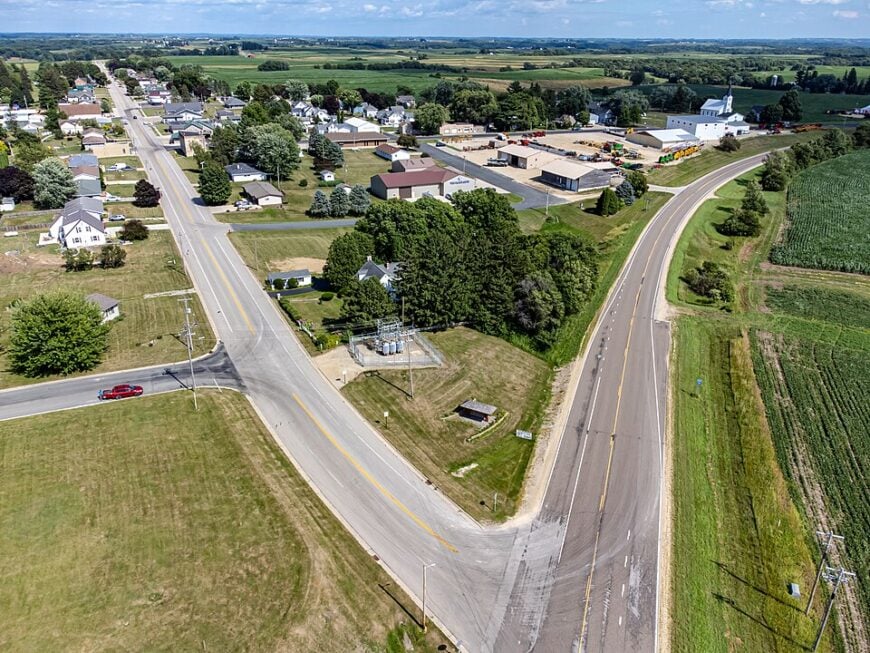
Eitzen’s 240 residents perch on a high ridge that overlooks folded valleys stretching into Iowa and Wisconsin. Days start early here with dairy chores, continue with afternoon drives to the feed mill, and wrap up at the town ballfield where the Eitzen Choppers play weekend tournaments.
Dairy farming and custom feed operations sustain the community, while a handful of vintage barns host seasonal agritourism events such as the popular Barn Quilt tour. Lacking chain stores or stoplights, the town’s main distractions are sweeping sunsets and the odd bald eagle catching thermals along the ridge.
Thick oak forests on the slopes and a two-state buffer around it contribute to a sense of standing on an island of high ground. Wind rustling corn leaves often out-volumes passing traffic on State Highway 76.
Where is Eitzen?
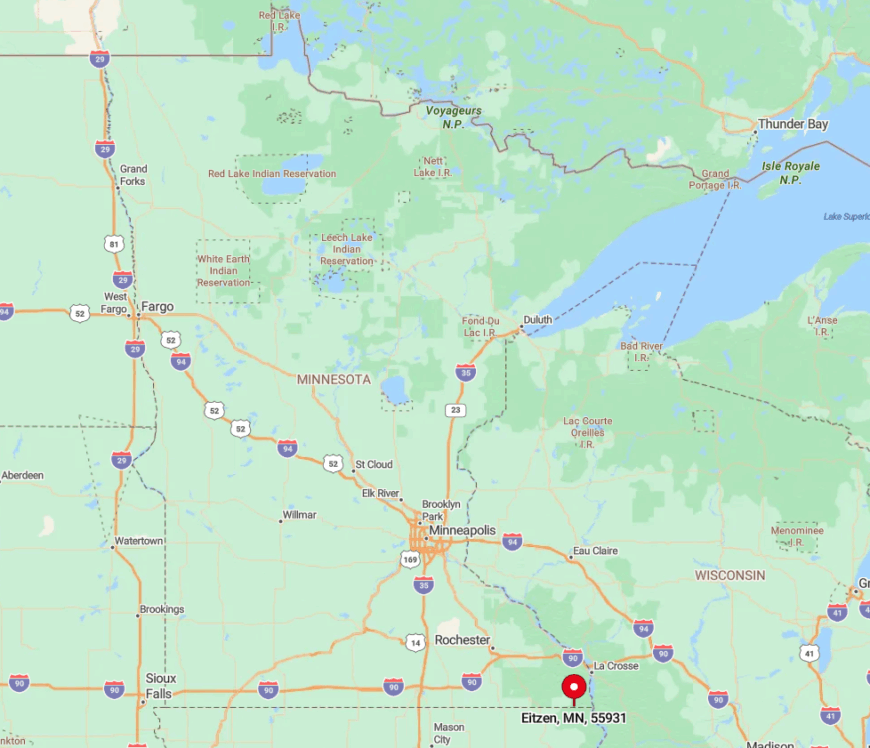
Eitzen anchors the extreme southeast corner of Minnesota in Houston County, one mile north of the Iowa state line along Highway 76. The nearest four-lane highway sits nearly 30 miles west, and the Mississippi river towns lie 25 miles east, leaving Eitzen away from any commuter corridor.
Approaches involve steep ridge climbs and hairpin descents that naturally slow vehicles. Those geographic hurdles keep visitor numbers modest and the ridge-line horizon pleasantly uncluttered.
4. Ostrander – Prairie-Meets-Pasture Crossroads
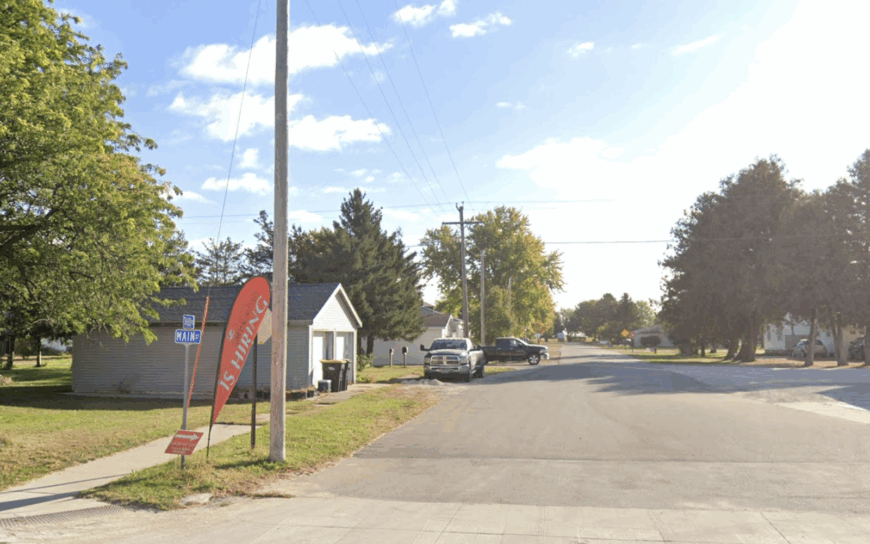
Ostrander’s population hovers near 250, most of whom gather at Susie’s Roadhouse Café for noon specials of meatloaf and mashed potatoes. A fringe of commercial cow-calf operations and cornfields maintains local employment along with a small lumberyard that supplies the surrounding farms.
Recreational life centers on the Shooting Star State Trail, which winds through tallgrass prairie remnants alive with blazing star, and on Friday evening sand volleyball behind the community center.
Two unnumbered dirt streets, a classic blacksmith shop, and endless horizon in every direction clarify why the place feels cut off from modern bustle. Without stoplights or even a gas station, night traffic virtually disappears. The quiet is broken only by meadowlarks greeting sunrise above gently waving brome grass.
Where is Ostrander?
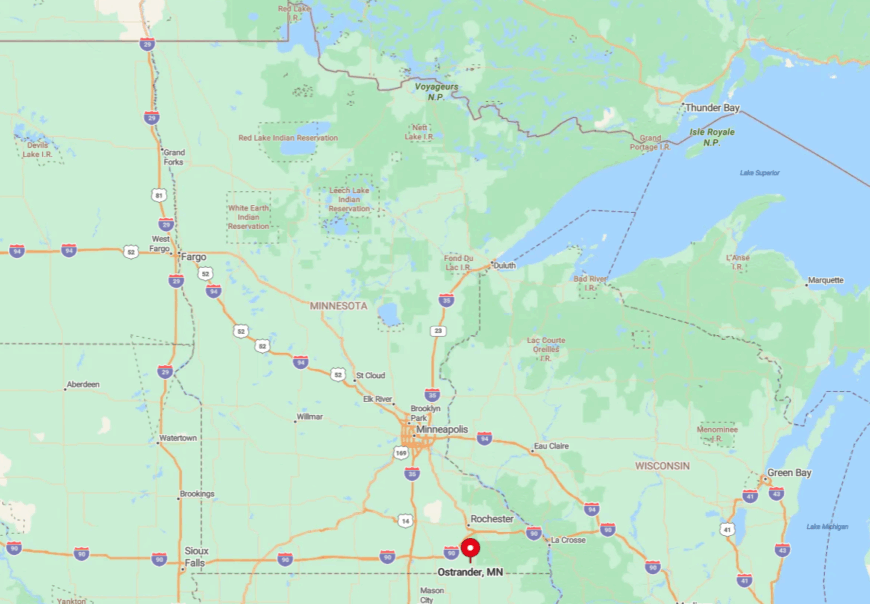
Located in northern Fillmore County at the intersection of County Roads 1 and 5, Ostrander sits 40 minutes south of Rochester and 15 minutes from the Iowa border. The nearest state highway runs six miles away, so anyone arriving has deliberately left faster pavement behind.
Approaches weave through square-mile farm sections where mailbox numbers outnumber neighbors. That subtle isolation lets the prairie town keep its unhurried pace while still resting within reach of city amenities if truly needed.
3. Kellogg – Eagle-Watching Mississippi Corridor Village
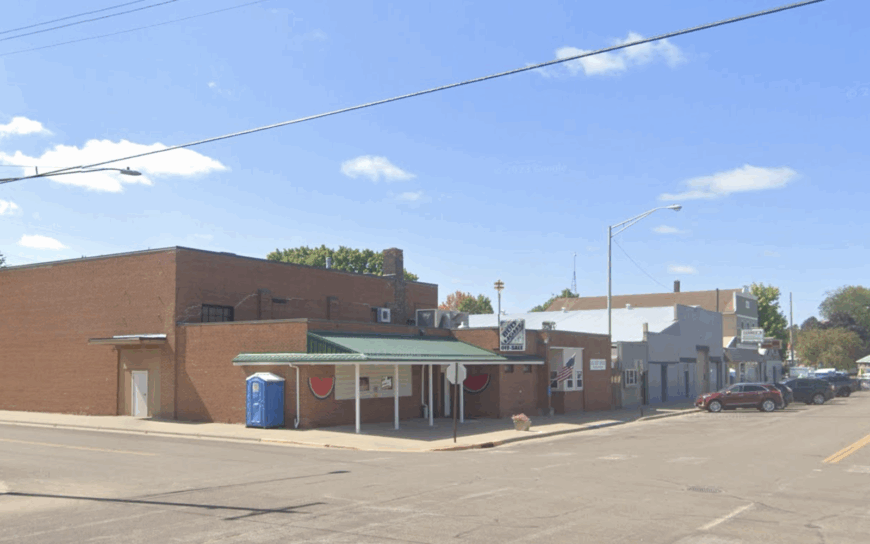
Kellogg shelters about 415 residents beneath towering river bluffs that funnel winter winds and migrating bald eagles alike. Birders flock to the riverside park in January to count dozens of eagles fishing open water below Lock and Dam 4, while summertime families ride the hand-carved carousel at nearby LARK Toys.
Agriculture, small-scale shipping from a river terminal, and specialty wood-carving studios form the bulk of local work. Despite its rail heritage, the town’s once-busy depot now serves as a museum, and passing trains slow through a curve that hugs the bluff face.
The combined wall of bluff stone on one side and the Mississippi on the other leaves little buildable land, naturally limiting growth. Even during eagle festivals, evenings settle into an easy rhythm of river frogs and distant tow-boat engines.
Where is Kellogg?
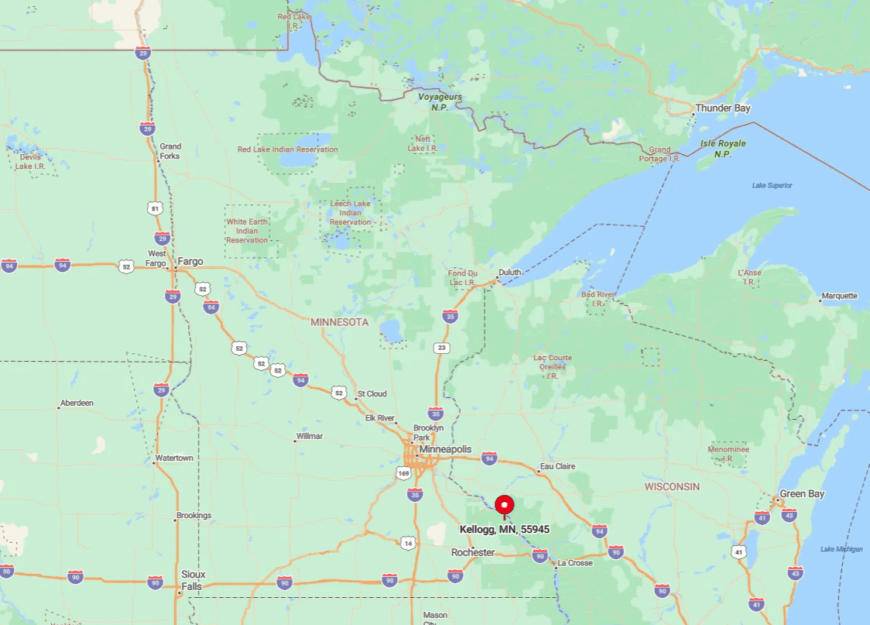
Kellogg sits on U.S. Highway 61, 10 miles south of Wabasha and 30 miles north of Winona, yet feels removed because the highway squeezes between water and rock, leaving no exit sprawl. Visitors reach the riverside park via one short spur road that dead-ends at a levee, so most vehicles simply pass by.
The Canadian Pacific rail line and the river itself hem the town in, preserving its slim footprint. Those physical limits help keep Kellogg’s center walkable and surprisingly serene given the highway’s closeness.
2. Utica – Oak Savanna Farmstead Pocket
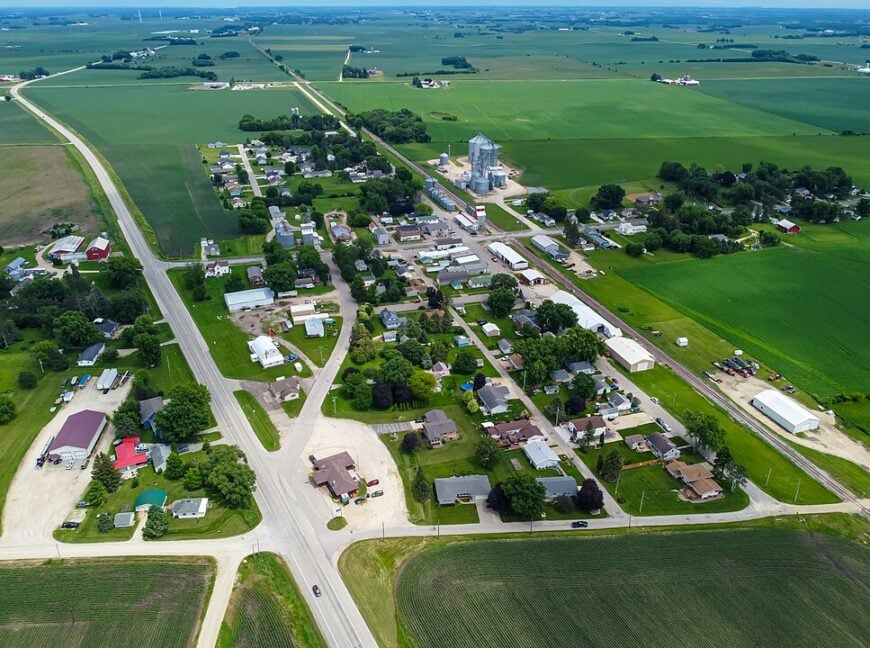
Utica counts roughly 290 residents, many living on broad acre lots shaded by bur oak and shagbark hickory. Weekends might include skeet shooting at the Sportsmen’s Club, tasting rhubarb wine at Garvin Heights Vineyard’s satellite shop, or biking the new signed loop connecting historic farmsteads.
Grain farming dominates the local economy, supplemented by a seed-corn plant and a respected custom cabinetry shop. Rochester’s suburban growth stops fifteen miles short, thanks to the buffer of oak savanna and state forestland that ring the village.
Those gently rolling woods interrupt sightlines and keep city light pollution low, turning Utica into its own little pocket of night-sky darkness. It is common to hear great horned owls before spotting a single streetlamp.
Where is Utica?
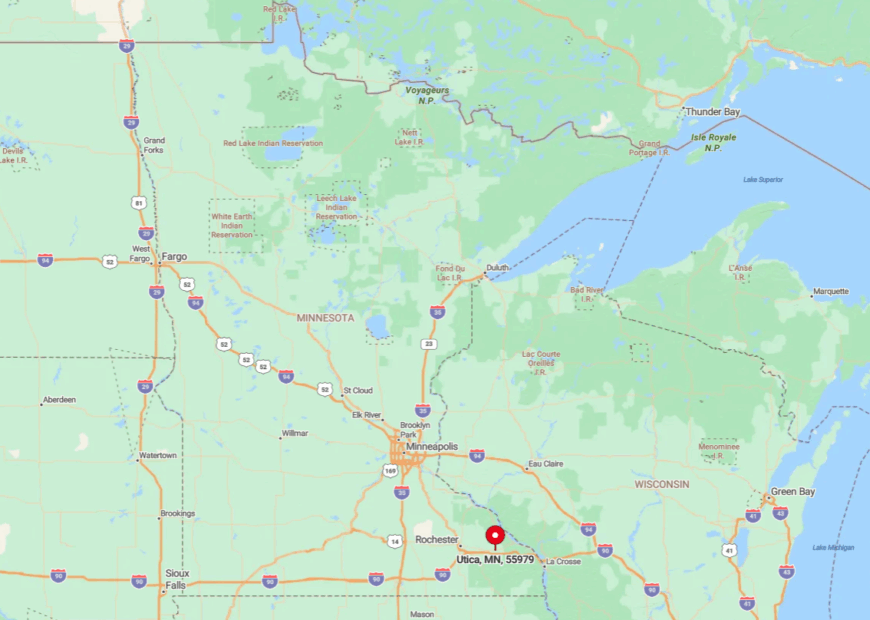
The village lies on U.S. Highway 14 between St. Charles and Lewiston, yet feels removed because County Roads 33 and 37 peel most through-traffic away toward Interstate 90. Approaching from Rochester, drivers crest a ridge then dip into a shallow bowl that hides Utica from view until the last minute.
Rail service ended decades ago and there is no bus link, leaving personal vehicle the only practical mode of access. That modest inconvenience preserves a sense of arrival every time the ridge opens and the stone church tower appears.
1. Fountain – Quiet Sinkhole Capital of the State
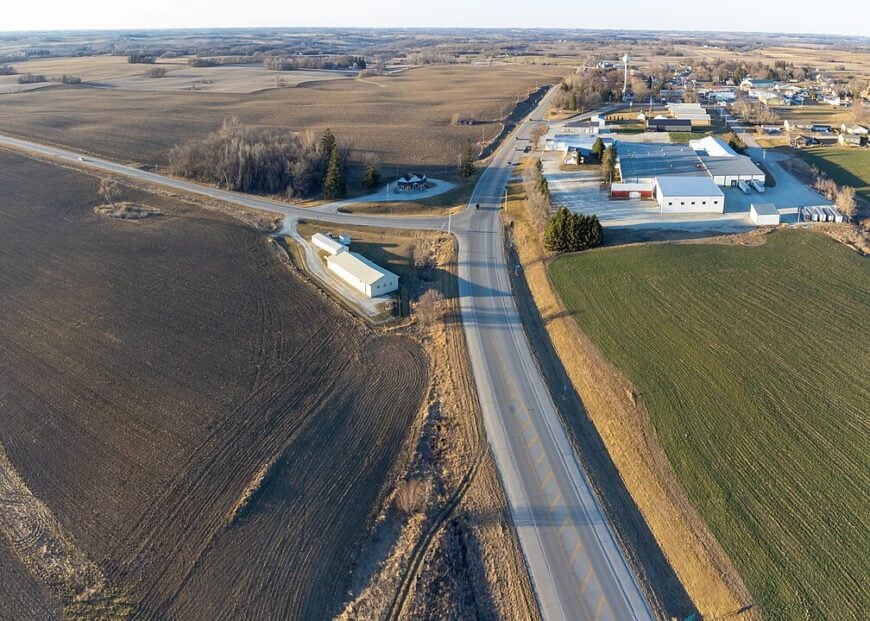
Fountain, with close to 410 residents, proudly bills itself as the Sinkhole Capital of Minnesota, and the pitted karst prairie surrounding town proves the slogan true.
Cyclists join the Root River Trail here to coast downhill toward Lanesboro, while spelunkers head seven miles south to explore Mystery Cave’s 13 miles of underground passages.
Agriculture and trail tourism split the economic pie, complemented by a volunteer-run geological museum explaining the region’s Swiss-cheese bedrock. The lack of large employers and the Swiss-cheese landscape itself deter major development, leaving prairie grasses and glacial erratics as the dominant skyline features.
Fountain sits atop a plateau where cell towers struggle to find purchase, ensuring patchy service that reinforces its sense of remoteness. Night skies reveal more constellations than billboards, and the hum you hear is often wind pushing through bluestem.
Where is Fountain?
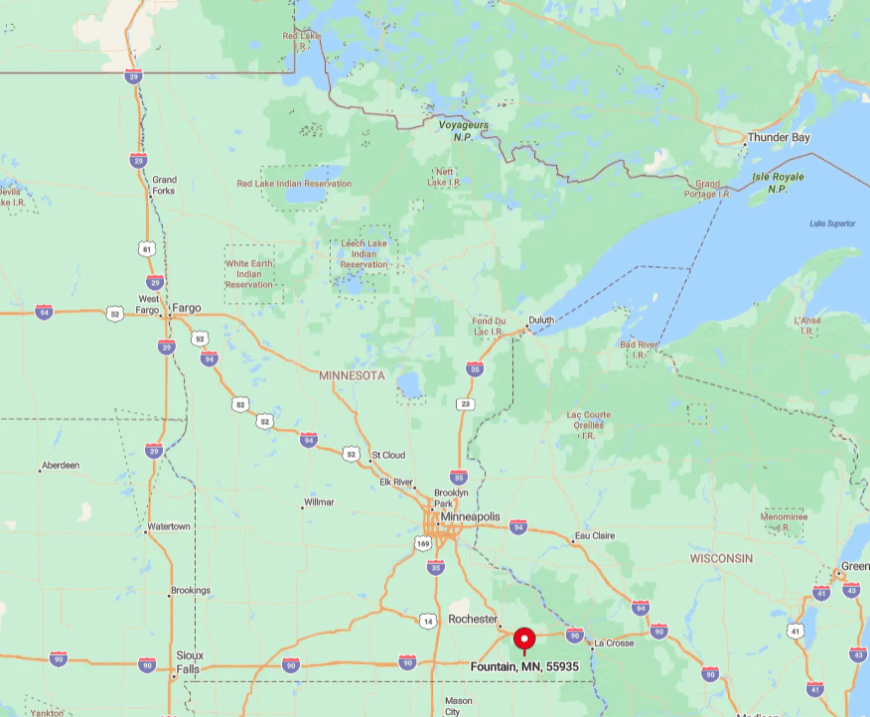
Fountain straddles U.S. Highway 52 in western Fillmore County, 35 miles south of Rochester, yet even highway travelers slip past unaware because the main street lies a block west behind tall maples.
The town marks the western terminus of the Root River State Trail, but automobile access requires leaving U.S. 52 onto County Road 8, a route that immediately dips into sinkhole-spotted pasture.
Freight trains quit the corridor decades ago and no regional bus line stops here, so visitors must arrive by bike or car. That combination of modest distance, minimal transit, and porous geology secures Fountain’s calm place on the prairie map.





